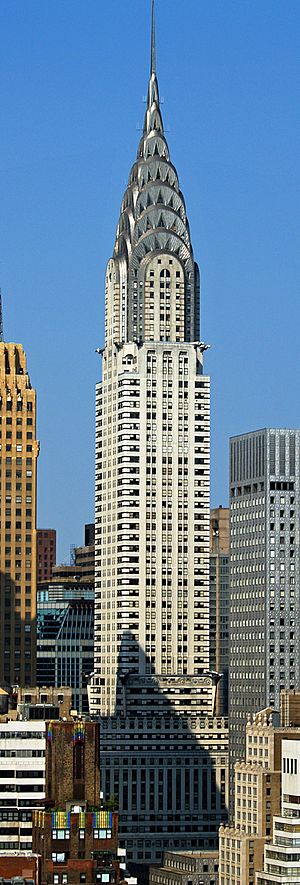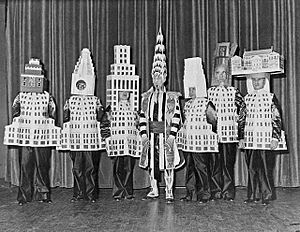William Van Alen facts for kids
Quick facts for kids
William Van Alen
|
|
|---|---|
| Born | August 10, 1883 Brooklyn, New York
|
| Died | May 24, 1954 (aged 70) New York City
|
| Nationality | American |
| Alma mater | Pratt Institute, Atelier Masqueray |
| Occupation | Architect |
| Practice | Clinton & Russell |
| Buildings | Chrysler Building |
William Van Alen (born August 10, 1883 – died May 24, 1954) was an American architect. He is most famous for designing the amazing Chrysler Building in New York City. This tall skyscraper was built between 1928 and 1930.
Contents
William Van Alen: Architect of Skyscrapers
Early Life and Education
William Van Alen was born in Brooklyn, New York, in 1883. His parents, James and Ina Van Alen, came from Dutch families.
He went to the Pratt Institute to study. At the same time, he worked for an architect named Clarence True. William also spent three years studying at the Atelier Masqueray. This was a special art and architecture school in the United States. It was started by a French-American architect, Emmanuel Louis Masqueray.
Starting His Career
After finishing his studies, Van Alen worked for different companies in New York. In 1902, he helped design the Hotel Astor for the firm Clinton & Russell. In 1908, he won a special scholarship called the Paris Prize. This allowed him to study in Paris at the famous École des Beaux-Arts.
When Van Alen came back to New York in 1910, he was very interested in new building styles. He liked modernism, which is a style he later became known for. In 1911, he teamed up with another architect, H. Craig Severance. They both liked modern architecture, but they were very different people. Severance was outgoing, while Van Alen was quieter.
Their partnership did well. They became known for designing unique tall buildings for businesses. In 1914, they built a structure in Lower Manhattan. It was special because its shop windows were flat with the walls. This was a new idea that later became common. In the 1920s, they started getting bigger projects. But their differences caused problems, and their partnership ended in 1924.
After the partnership ended, both Severance and Van Alen continued to work on their own. Van Alen found it hard to get big projects at first. He kept his office going with smaller jobs. In the mid-1920s, he got two projects from Childs Restaurants. This was an early restaurant chain known for its interesting buildings.
In 1925, he designed a slender, six-story building in Manhattan. It had curved glass corner windows without a supporting post. This was another new idea that became popular. This building had a Childs restaurant on its lower floors. Famous architects like Le Corbusier noticed it.
His design for another Childs restaurant in Washington, D.C., was very different. Built in 1926, it was a single-story stone building. It had large arched windows. Even though Childs restaurants left these buildings in the 1950s, they were still in use in 2014. The Manhattan building was a restaurant, and the Washington building was a bank.
The Tallest Building Race
In the late 1920s, Severance and Van Alen found themselves in a friendly competition. They were both designing buildings that the newspapers said would be the tallest in the world. Severance was designing 40 Wall Street. Van Alen was designing the Chrysler Building.
Van Alen's Chrysler Building won the race, reaching 1046 feet. However, both buildings were soon beaten in height by the Empire State Building in 1931.
The Chrysler Building's Impact
When the Chrysler Building was finished, people had mixed feelings about it. Some called Van Alen a "Doctor of Altitude" and praised his work. But other critics said the building was just flashy. They felt it was designed only to make people look up, not as serious architecture.
Despite these different opinions, the Chrysler Building is still a much-loved landmark in New York City.
After the building was completed, Van Alen asked Walter Chrysler for his payment. He asked for 6 percent of the building's cost, which was the usual fee. Chrysler refused to pay, so Van Alen sued him. Van Alen won the lawsuit and eventually received his payment. However, this legal battle hurt his reputation. It became harder for him to get new projects. The Great Depression also made things difficult for architects. After this, Van Alen spent more time teaching sculpture.
His Lasting Legacy
William Van Alen's name lives on through the Van Alen Institute. This is a non-profit group in New York City. It works to make public spaces better through exhibitions, competitions, and workshops. The Institute was started in 1894 as the Society of Beaux-Arts Architects. In 1996, it was renamed in honor of Van Alen, who was a major supporter. At that time, the group began to focus on public spaces. The Institute helps different experts and community leaders work together on projects.
The Van Alen Building in Brighton, England, was also named after him. It's a luxury apartment building by the sea. This building was built between 1999 and 2001. It has 38 apartments and features a modern design style.
See also
 In Spanish: William van Alen para niños
In Spanish: William van Alen para niños




